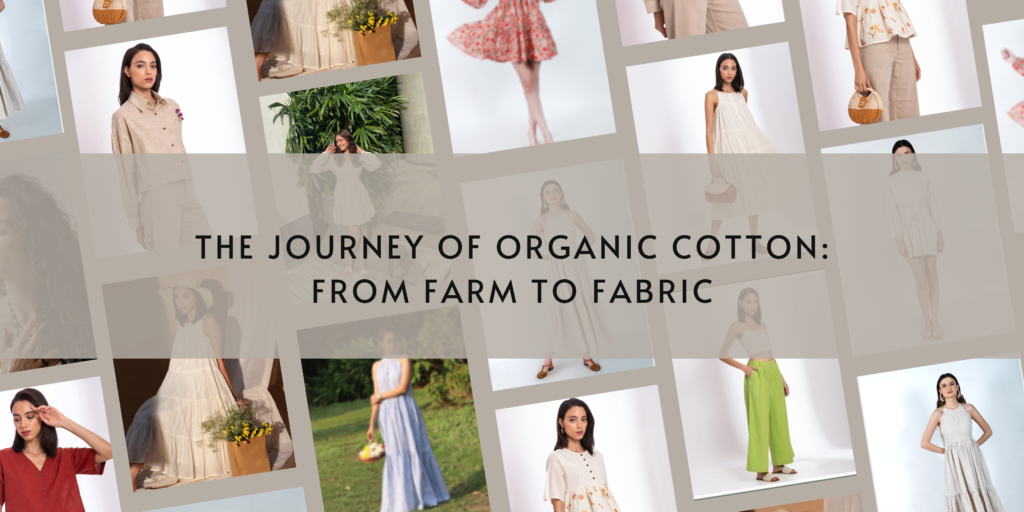
Cotton is comfy, right? That soft t-shirt or cozy hoodie you love – chances are it’s made from cotton. But did you ever wonder where that cotton comes from? And why should you care? Well, get ready for a trip from the cotton farm to your wardrobe as we explore the fascinating journey of organic cotton.
Chapter 1: The Organic Cotton Farm
We start our journey on a cotton farm. Think of it as a big, sunny field full of cotton plants. Organic cotton farming is like nature’s best friend. Here’s how it’s different from regular cotton farming:
- No Nasty Chemicals: Organic cotton is grown without using those yucky synthetic pesticides or genetically modified stuff (GMOs). Instead, farmers use natural tricks, like friendly bugs, to keep pests away.
- Soil Hug: Organic farms take care of the soil. They rotate crops and add compost to keep it healthy. No need for synthetic fertilizers!
- Water Wise: Water is precious, right? Organic cotton farms use water wisely. They often rely on rain or smart watering systems to use less water.
- Wild and Wonderful: On organic farms, it’s like a party for all sorts of plants and critters. There’s a mix of plants, not just endless cotton rows. It’s like a mini jungle!
Chapter 2: The Harvest
When those cotton plants burst with fluffy white balls, it’s time to pick ’em. Organic cotton is usually handpicked. Yep, people do the picking, not machines. Why does it matter?
- Gentle Touch: Handpicking is gentle. It doesn’t rough up the cotton fibers like machines can. That means softer cotton for your clothes.
- No Chemical Chaos: Regular cotton is often picked with chemicals that make leaves fall off. Organic cotton doesn’t play with chemicals, so it’s safer for everyone.
Chapter 3: Ginning – Getting Clean
Next stop, the cotton gin. No, not the drink – it’s a machine that separates the cotton fibers from the seeds and cleans them up. Here’s the deal:
- No Nasty Sprays: Like in harvesting, organic cotton ginning skips the chemical defoliants used in conventional cotton farming.
- Clean and Green: Organic cotton ginning places a big bet on eco-friendly practices, like proper waste management and saving energy.
Chapter 4: Spinning a Yarn
Now, it’s time to spin some magic. The cleaned cotton goes through machines that turn it into yarn. Organic cotton yarn-making is all about keeping it green:
- Dyeing Drama: When they add color, many organic cotton folks go for low-impact or natural dyes. Less harm to the planet and your skin!
- Water Wisps: They’re careful with water during dyeing, so not a drop goes to waste.
Chapter 5: Weaving the Fabric
The yarn gets woven into fabric on big looms. Even here, they keep the eco vibe alive:
- Energy Saver: Many organic cotton mills use energy wisely. Some even switch to renewable energy sources.
- Trash Talk: They’re no fans of waste. Recycling and being smart about leftovers is their thing.
Chapter 6: Ethical Manufacturing
The fabric is ready, but our journey isn’t over yet. Time to sew it into clothing or other cool stuff. Organic clothing brands are all about doing the right thing:
- Fair Pay: Workers get fair wages. It’s like they’re saying, “You work hard, you deserve a good paycheck.”
- Safety First: Safe and comfy working conditions are a must. No shortcuts here!
- Transparency: Many organic clothing brands spill the beans on how they make stuff. They want you to know what’s happening behind the scenes.
Chapter 7: The Arrival of Organic Cotton Goodies
Ta-da! Here come the organic cotton products. They’re soft, comfy, and they’re on a mission to make the world better:
- Comfy and Cool: Organic cotton products feel great, and they last because they’re well-made.
- Earth Lover: By choosing organic cotton, you’re telling the planet, “Hey, I care about you!” It’s like giving Earth a friendly hug.
In Conclusion
The journey of organic cotton is a story of nature-friendly choices. When you wear organic cotton, you’re not just feeling comfy; you’re making a difference. You’re supporting farmers who use fewer chemicals, conserving water, and making sure workers are treated right.
So, next time you pull on that soft organic cotton t-shirt, remember the adventure it had – from a sunny field to your wardrobe, making the world a little greener along the way. It’s more than just clothing; it’s a journey of care for you and our beautiful planet.
Content By: Palison
